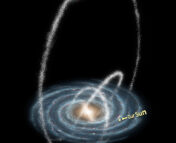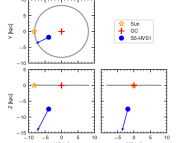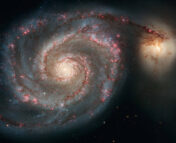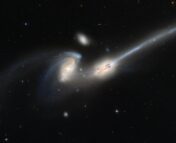Authors: P. Awad, M. Canducci, E. Balbinot, et al.
First Author’s Institution: Kapteyn Astronomical Institute, University of Groningen, The Netherlands; Bernoulli Institute for Mathematics, Computer Science and Artificial Intelligence, The Netherlands
Status: open access on the arXiv
On the large scales, galaxies (at least locally) fairly neatly fall into the familiar classes of shapes ranging from spiral to elliptical and variants in-between. When we take a magnifying glass to these objects, however, it turns out that everything isn’t quite so orderly. In fact, galaxies display a remarkable degree of complex substructure and our own Galaxy provides the perfect testbed to understand where, when, and how such intricate structures may have emerged. For example, in our Milky Way galaxy alone, we observe structures ranging from clumps (or ‘clusters’) of stars and miniature galactic satellites to filamentary, ‘stream’-like associations of stars.
These streams of stars (called stellar streams) offer an unprecedented lens into our Galaxy’s troubled past. Our canonical picture of galaxy evolution dictates that these objects grow hierarchically, meaning that the smallest objects form first and grow first through inflows of gas from the ambient intergalactic medium, and later through mergers and interactions with other objects in the local cosmic web. As these small satellite galaxies circle around and interact with our own, the gravitational field of our galaxy has the power to stretch and tear them apart, leaving behind structures such as these stellar streams over several passages. Therefore, analyzing these streams and reverse engineering the choreography of this intragalactic dance allows us to understand how and when our Galaxy grew. In turn, because these structures are a direct byproduct of the gravitational structure of our Galaxy, they also provide a probe of the distribution of mass in their vicinity—which will be sensitive to both luminous and dark matter alike.
Motivated by this, today’s authors take a deep dive into modeling the structure of one such stellar stream, the Jhelum stream. Much like a child taking a magnifying glass to the sandbox at school, as they peer through their own galactic magnifying glass, today’s authors treat the sample of stars they are analyzing as a population of ants. By characterizing the distribution of stars in the Jhelum stream, today’s authors hope to understand where exactly the stream came from and pin down what sort of object may have led to its formation.
Ants on a log in a galaxy?
Okay, so back to the ants. When modeling a stellar stream in a low-density region of the galaxy, such as in the galactic halo, it might seem easy enough to visually identify the stars associated with the stream—these high-density filaments would stand out like in this picture. When searching amidst the rest of the stars in the galaxy, such a task becomes more complex and the likelihood of contamination just by spatial association is high. In other words, you can’t just identify all the members of a stream just by selecting all nearby stars to its location. To get around this, astronomers have traditionally tried to leverage every piece of information they can find about the stars populating these streams. That is, by folding together the stellar positions, motions, and spectral types, one can construct a more holistic view of the stars in any given region of the galaxy and identify which ones might have arrived in that place together. However, when working with thousands of stars, identifying the correct way to slice up this multidimensional parameter space is complex. Rather than trying to figure this out themselves, today’s authors decide to outsource this problem to ants!
In particular, today’s authors make use of a dimensionality-reduction technique (read: a way to identify substructures in complex data) known as the ‘locally aligned ant technique’ (LAAT) that falls in the class of “ant colony optimization” (ACO) algorithms. The basic premise of such an algorithm is inspired by the behavior of ants in a colony. To begin, ‘ants’ are dispersed randomly throughout the dataset and allowed to start wandering around—in practice, the ants occupy coordinates in position and velocity space and walk from data point to data point, exploring the space. As these walkers move, they deposit numerical markers which act as the pheromones left behind by real ants. Once this happens, the movements of the ‘ants’ are no longer entirely random and they choose to preferentially follow paths of high pheromone density, basically tracing the paths that other fellow ants have previously taken. Because the pheromones have a prescribed ‘evaporation rate’, ones that are left behind in low-density regions will quickly fade, so once the algorithm is run, one will be left with a pheromone distribution that reflects the presence of high-density, lower-dimensional structures within the original high-dimensional space of data. For example, if one starts with a six-dimensional space of 3D positions and velocities, the behavior of the ants could help tease out the spatial location of these one-two dimensional streams and identify the proper motions of the component stellar associations.
Today’s authors start this analysis with the sample of stars previously identified as members of the Jhelum stream based on their positions, velocities, and placement on a color-magnitude diagram (which can be used to highlight a collection of stars with shared ages) using data from the Gaia satellite and the Southern Stellar Stream Spectroscopic Survey. Within this group of stars they deploy their ants and set them free to wander, following the aforementioned framework. To this they add one extra degree of complexity. Rather than just having the ants walk towards regions of high pheromone density in any way, they dictate that the ants should move along the direction of local substructures, identified by using principal component analysis (PCA) on the stars in the local neighborhood of every ant. Once this procedure had converged, they selected the stars belonging to regions of high pheromone density, applied a cut in the color magnitude diagram to further refine the selection of stars that should have similar ages, and deployed the ants once again. Carrying this out iteratively until they were reasonably confident that they’d gotten rid of any contaminants, they were left with a sample of stars that were localized spatially, temporally (in terms of ages), and kinematically, as is shown in Figure 1 .
Diving into the stream
With the stars in the stream identified, today’s authors could begin to analyze the properties of this population to try and understand the stream’s provenance. They begin this analysis by studying the stars in the two overdense regions in the bottom-right panel of Figure 1—that is, they model the stars that appear to be moving together. By fitting a pair of Gaussian distributions to the motions of these stars, they were able to determine the presence of two components co-located in the one-dimensional stream: a wide and narrow component (see Figure 2).
Next, they modeled the orbits of the stars belonging to the two components of the stream and, from this, were able to estimate the spread of velocities (or velocity ‘dispersion’) in these components. These estimates, combined with the spatial width of the stream, begin to paint a picture of the stream’s history. Namely, the narrow component displays a corresponding narrow range of stellar velocities, consistent with observations of other streams that are believed to have originated from infalling globular clusters. The wide component, on the other hand, appears to align better with the properties expected of a dwarf galaxy interacting with the Milky Way. The combination of these two pieces (and folding in preliminary evidence on the distribution of metallicities in the components), tentatively supports a formation channel for this stream: it is the result of a merger of a globular cluster hosted in a dwarf galaxy and our own galaxy. This analysis preliminarily suggests that such a progenitor dwarf galaxy would have been 1-10 million times the mass of our Sun (but would be a thousand times smaller than the Magellanic Clouds, for example).
Moving forward, follow-up observations of the members of the stream—for example, through high-resolution spectroscopy—would help evaluate the viability of these scenarios and refinement of the ant algorithm would add more detail into the substructure one could model, but this work presents an exciting application of this procedure to help begin to understand one of our Galaxy’s mysterious streams.
Astrobite edited by Karthik Yadavalli
Featured image credit: adapted from pixabay




